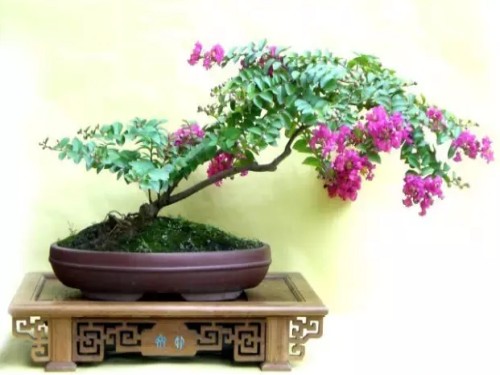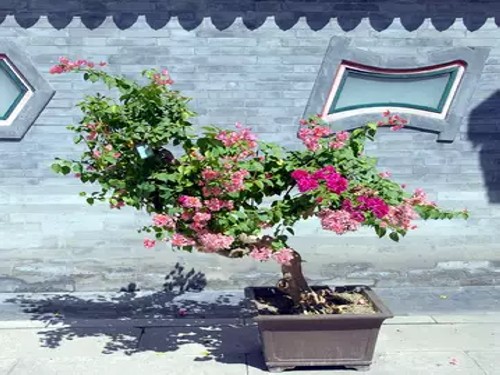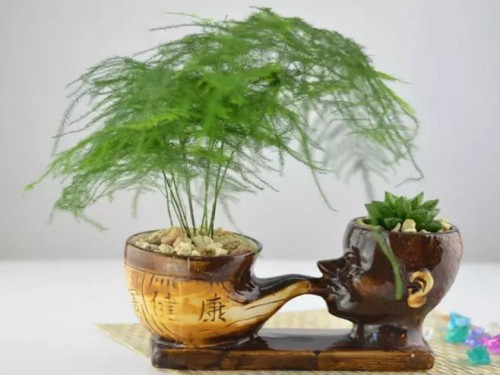How to trim crape myrtle bonsai
Crape myrtle is a very interesting flower tree, it has a characteristic: "crape myrtle blossoms for a hundred days, gently caressing the branches and branches to move the whole tree." Therefore, crape myrtle is also known as the itching tree. Crape myrtle tree has beautiful appearance, curved branches and bright flowers, and blossoms in summer and autumn. It is an important ornamental tree species in summer and autumn. Due to the continuous cultivation and breeding of growers, the popular varieties are: fast-growing rose crape myrtle, Wenjiang Erhong crape myrtle, fast-growing red crape myrtle, Japanese red-leaf tree crape myrtle, red rocket crape myrtle, red fireball crape myrtle, American velvet crape myrtle and so on.
Crape myrtle is a flower-watching bonsai, with hard xylem and slender branches, which is not easy to climb and make feathering. Crape myrtle has strong germination and resistance to pruning. Through cutting, thinning and shaping, and combined with the management of fertilizer and water, crape myrtle can cultivate bonsai with beautiful shape and blooming year after year in a short time.

There are two methods of pruning: shortening and thinning.
First, to cut short is to truncate the dry branches and store them. First of all, the height of the first section of the trunk is determined, and then when the trunk reaches a certain thickness by culture, the trunk is cut off to form the second section. Some can be cut once a year, and each section can be kept 5cm to 20cm according to the modeling needs. While truncating the trunk, lateral branches should be cultivated at the same time, that is, the branches should be cultivated synchronously to make them thicker, heighten and grow. Through 2-3 years or more time of cultivation and reasonable cutting, the tree body is graceful, the branches are straight and curved, and the lateral branches are many, dense and natural.
Second, thinning means cutting off branches that are too dense. Pruning generally includes winter pruning, usual pruning and post-flowering pruning.
(1) winter pruning. The technique of heavy cutting can be adopted. At this time, the trees are dormant, the branches are short after pruning, and when the nutrition is concentrated on the short branches, the buds germinate strongly, and the new branches are strong, which is beneficial to the second (summer or winter) re-pruning. When cutting, there are 1 or 2 main branches on each stem, pay attention to the level and structure. The pruning of branches generally leaves 3-5 cm per node, the bottom branch can be longer, each node of the upper branch is shorter than the bottom, and the lateral branch is cut to about 3 cm.
(2) pruning at ordinary times. In the growing season, cut off the sprouting branches from the roots in time, and cut symmetrical branches, cross branches and long branches. The tree tree is not allowed to blossom at the stage of cultivation. Before the formation of summer buds, cut off the inflorescence in time, shout less a large amount of nutrients needed for flowering, and maintain the normal growth of branches □ when the new long branches are lignified, cut short to form curved stems and twigs. New shoots sprouting in spring cannot be cut short to allow annual branches to blossom at the top of buds.
(3) pruning after flowering. The flowering period is basically over in the middle of October, the flower branches should be cut off in time, the flower branches should be cut off if the opening angle is not suitable, and the flower branches to be left should be cut short according to the requirements.
Crape myrtle bonsai needs a strong pruning in winter. New shoots and shoots sprout in the first ten days of April next year, and grow quickly after sprouting, and the new shoots can reach about 15 cm in the first and middle of May. At this time, the new shoots are trimmed and peeled, keeping the new branches about 8 cm to 10 cm, and the upper parts are all cut off, prompting it to grow double branches at the top, leaving spare branches, and cutting off all other unused branches, such as parallel branches, bore branches, overlapping branches, overgrown branches, and so on.
In mid-June, double-branched branches grow at the top of the pruned branches, and inflorescences will grow when the new branches grow to about 8 cm. At this time, one of the double-branched branches will be pruned. Cut off the lower part of the pedicel and the top of the bud (as a branch that blossoms for the second time).
The first flowering is in the first and middle of July, the flowers are neat and concentrated, and the residual flowers are cut off in time after flowering to promote the axillary buds to grow new branches (as the branches of the third flowering), and the residual flowers should also be cut off after the second flowering. Promote it to grow new branches (as the fourth flowering branch), the third flowering in mid-late August, cut off the residual flowers in the same way after flowering. The fourth flowering is in late September. If the annual temperature is normal, crape myrtle will blossom for the fifth time.
Time: 2019-06-10 Click:
- Prev

Modeling method of crape myrtle bonsai
Crape myrtle has been a very good bonsai tree since ancient times, and it is one of the pile landscape Rocks of Eighteen Scholars. It is widely used in the Huizhou school and Sichuan school in the traditional eight pile landscape schools. Crape myrtle has the characteristic of exposing its roots, and the older the tree is, the more Qiu qu its roots are, which has a vigorous, simple, elegant and finishing effect.
- Next

How to shape asparagus-the modeling method of asparagus bonsai
Asparagus, also known as Pinus elliottii, Phyllostachys pubescens, Phyllostachys pubescens, is an evergreen foliage plant with high ornamental value. it is a plant of the genus asparagus of Liliaceae. The root of asparagus can be used as medicine and has the effect of treating acute tracheitis and relieving cough. It is mainly used to observe leaves in potted plants, and it is also an important leaf-cutting material.
Related
- Fuxing push coffee new agricultural production and marketing class: lack of small-scale processing plants
- Jujube rice field leisure farm deep ploughing Yilan for five years to create a space for organic food and play
- Nongyu Farm-A trial of organic papaya for brave women with advanced technology
- Four points for attention in the prevention and control of diseases and insect pests of edible fungi
- How to add nutrient solution to Edible Fungi
- Is there any good way to control edible fungus mites?
- Open Inoculation Technology of Edible Fungi
- Is there any clever way to use fertilizer for edible fungus in winter?
- What agents are used to kill the pathogens of edible fungi in the mushroom shed?
- Rapid drying of Edible Fungi

